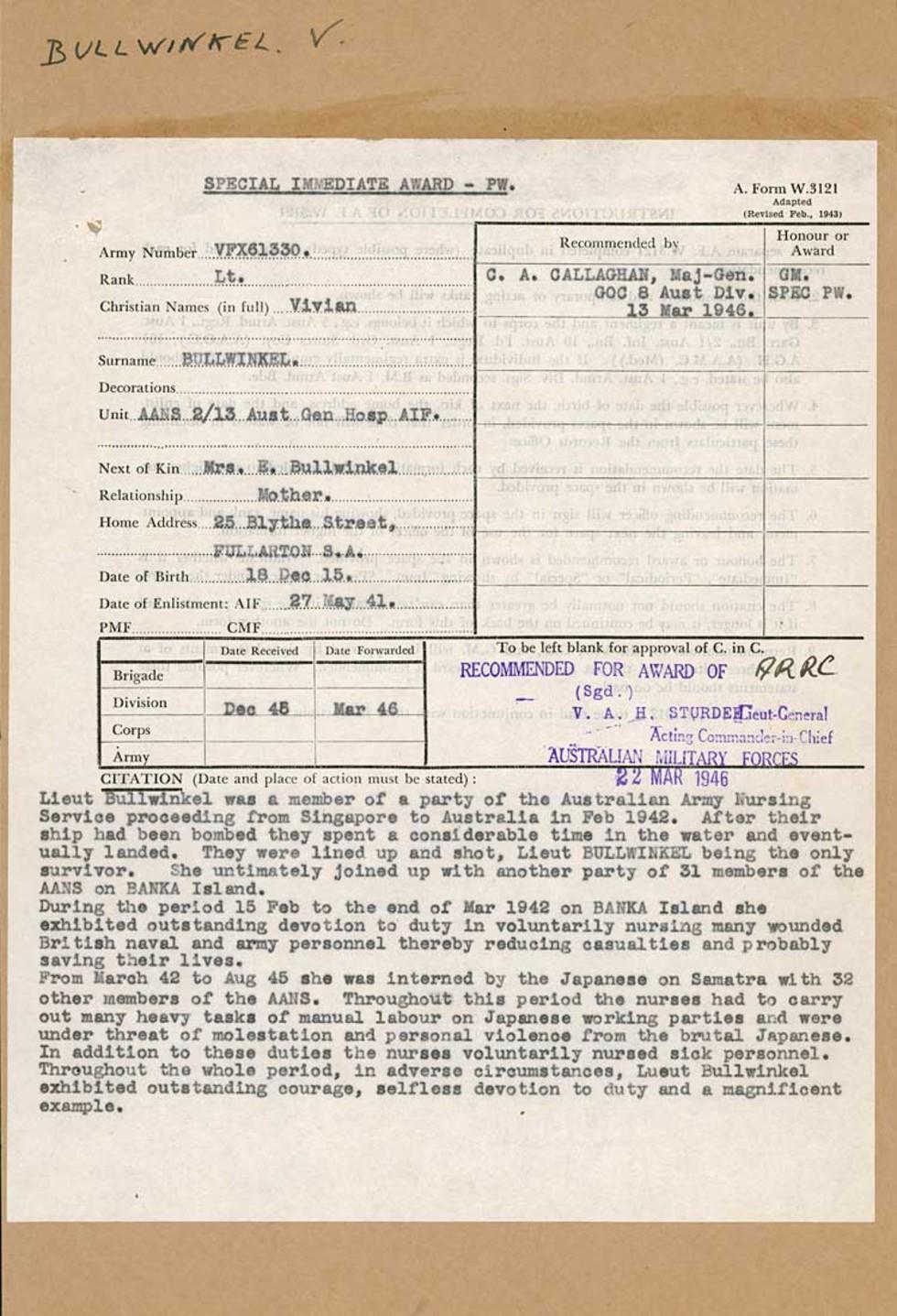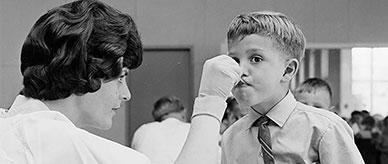


Transcript
BULLWINKEL, V.
[Heading:] SPECIAL IMMEDIATE AWARD – PW.
Army Number VFX61330.
Rank Lt. [Lieutenant]
Christian Names (in full) Vivian
Surname BULLWINKEL.
Decorations [response blank]
Unit AANS 2/13 Aust Gen Hosp AIF [Australian General Hospital Australian Imperial Force]
Next of Kin Mrs E. Bullwinkel
Relationship Mother.
Home Address 25 Blythe Street,
FULLARTON S.A.
Date of Birth 18 Dec 15.
Date of Enlistment: 27 May 41.
PMF [Permanent Military Forces] [response blank]
CMF [Citizen Military Forces] [response blank]
Recommended by
C. A. CALLAGHAN, Maj-Gen [Major-General].
GOC 8 Aust Div [Australian Division].
13 Mar 1946.
Honour or Award
GM.
SPEC PW.
[A table with rows labelled 'Brigade', 'Division', 'Corps', and 'Army'. Only the row labelled 'Division' contains responses.]
Date Received
Dec 45
Date Forwarded
Mar 46
To be left blank for approval of C. in C. [Commander in Chief]
[Stamped in purple ink:]
RECOMMENDED FOR AWARD OF [Handwritten] ARRC [Associate of the Royal Red Cross] [end handwritten]
- (Sgd.)
V. A. H. STURDEE Lieut-General [Lieutenant-General]
Acting Commander-in-Chief
AUSTRALIAN MILITARY FORCES
22 MAR 1946
[End stamp]
CITATION [underlined] (Date and place of action must be stated):
[the following response is typed]
Lieut Bullwinkel was a member of a party of the Australian Army Nursing Service proceeding from Singapore to Australia in Feb 1942. After their ship had been bombed they spent a considerable time in the water and eventually landed. They were lined up and shot, Lieut BULLWINKEL being the only survivor. She untimately [sic] joined up with another party of 31 members of the AANS [Australian Army Nursing Service] on BANKA island.
During the period 15 Feb to the end of Mar 1942 on BANKA island she exhibited outstanding devotion to duty in voluntarily nursing many wounded British naval and army personnel thereby reducing casualties and probably saving their lives.
From March 42 to Aug 45 she was interned by the Japanese on Samatra [sic] with 32 other members of the AANS. throughout this period the nurses had to carry out many heavy tasks of manual labour on [sic] Japanese working parties and were under threat of molestation and personal violence from the brutal Japanese. In addition to these duties the nurses voluntarily nursed sick personnel. Throughout the whole period, in adverse circumstances, Lueut [sic] Bullwinkel exhibited outstanding courage, selfless devotion to duty and a magnificent example.
About this record
This is the formal recommendation for Lieutenant Vivian Bullwinkel's award of Associate of the Royal Red Cross (ARRC). The form gives her army personnel details before proceeding to outline her actions leading to the recommendation of the award for her courage and devotion to duty. The stamp of Lieutenant-General VAH Sturdee approves the recommendation that Bullwinkel be awarded the ARRC. This recommendation is dated 22 March 1946.
Educational value
- This document records one of the most infamous wartime stories in Australian history. Vivian Stratham Bullwinkel (1915–2000), a nurse in the Australian Army Nursing Service, was evacuated with other Australian nurses from Singapore in February 1942 shortly before the island surrendered to the Japanese. She survived the sinking of her evacuation ship, the Vyner Brooke, and, after reaching land and being captured, survived a Japanese massacre.
- Bullwinkel's story inspired the general public and she is remembered as an example of Australian spirit and determination. The recommendation describes both her experiences as the sole survivor of what became known as the Banka Island Massacre and her selfless devotion to others during her harrowing time in a Japanese prisoner of war (POW) camp.
- After the Vyner Brooke was bombed in February 1942 Bullwinkel, along with 21 other nurses, some civilians and almost 100 soldiers landed on Banka Island. The civilian women and children left to find an authority to surrender to. The nurses, soldiers and wounded were found by Japanese soldiers. The men were taken away and killed before the nurses were ordered back into the sea and machine-gunned from behind. Bullwinkel, who was wounded, was the only survivor.
- The document also records details of what happened to Vivian Bullwinkel after the massacre. After eventually surrendering to the Japanese, Bullwinkel was held in a POW camp until August 1945 with other nurses from the ship who had escaped before the massacre. Only 24 of the original 65 Vyner Brooke nurses survived the war. Bullwinkel later testified at a war crimes trial.
- Bullwinkel’s recommendation for the award of Associate of the Royal Red Cross, which is presented only to military nurses for showing exceptional service, was endorsed by the Acting Commander in Chief, Australian Military Forces, on 22 March 1946. However, it was nearly a year later before the award was gazetted (came into effect) on 6 March 1947.
- The Associate of the Royal Red Cross Award was one of a series of honours acknowledging Bullwinkel's courage and selflessness. After the war, she continued her services to nursing, to the veteran and ex-POW communities and the Red Cross Society. She received the Florence Nightingale Medal and was made a Member of the Order of Australia (AO) and a Member of the British Empire. She also became President of the Australian College of Nursing.
Acknowledgments
Learning resource text © Education Services Australia Limited and the National Archives of Australia 2010.
Related themes
Need help with your research?
Learn how to interpret primary sources, use our collection and more.


